The goal is not to understand how to thrive in any future, but to explore options to create a much better future.
Four potential futures for racial equity in the United States
Though many organizations committed to racial equity in 2020, the path to get there will likely be a winding one. Without meaningful action taken now to address racial inequity, specifically for Black people, there is no guarantee that the near future will be substantially different than the recent past. And even with meaningful action, the path toward equity could take many unexpected turns or unintended switchbacks.
In late 2020, we developed scenarios designed to better understand what that path might look like. These scenarios propose different responses to the question: How will the journey toward racial equity in the United States evolve over the next 10—15 years?
Note to the reader
These scenarios describe the world as it might be in the 2030s. By then, at least some efforts on behalf of Black Americans could change US society more broadly, so some of these scenarios describe dynamics not just for Black Americans, but also among a wider group some refer to as “PEERs”—Persons Excluded due to Ethnicity or Race, which includes people who identify as Black, Latinx, and people indigenous to the United States and its territories. In at least some of the futures we can imagine, 10 to 15 years of change could have measurable impact on this broader group.
What are scenarios and why do we use them?
Scenarios are stories about what the future may be like, created through a structured process and designed to challenge conventional wisdom, stretch thinking, and help drive better decisions today. They are not predictions about what will happen, nor do they express our expectations about what should happen. Scenarios describe imaginative possibilities that could happen under different conditions, and the details included in each are added to suggest potential events or trends one might see in a future with these characteristics.
Even though scenarios are fictional, leaders often use scenario-based thinking because scenarios can help them see how the future might present unexpected opportunities and risks.
Many readers may be familiar with scenarios created to help leaders identify good options for a variety of plausible futures. The scenarios here are different. The goal is not to understand how to thrive in any future, but to explore options to create a much better future. And, practically speaking, they help us challenge our own assumptions and legacy practices in order to focus on actions that could progress toward a more equitable future.
What might shape the future?
Scenarios illuminate possibilities for the future by focusing on large, macro-level issues that are important but fundamentally uncertain. Understanding how those uncertainties could play out over time allows us to imagine how the trends we see today could generate different realities tomorrow.
Deloitte research identified a variety of uncertainties likely to shape how the future of racial equity in the United States may unfold. Input from "Changemakers"—leaders in the public, private, and social sectors committed to driving racial equity—helped identify several important uncertainties, two of which stood out as being particularly consequential.
The first uncertainty is the extent and characteristics of social cooperation across the United States. Will people primarily look out for their own self-interest, and—believing that opportunity is ultimately a zero-sum game—create a fragmented society of conflicting interests? Or will they find broader and more extensive bases for cooperation, believing in more mutual benefit?
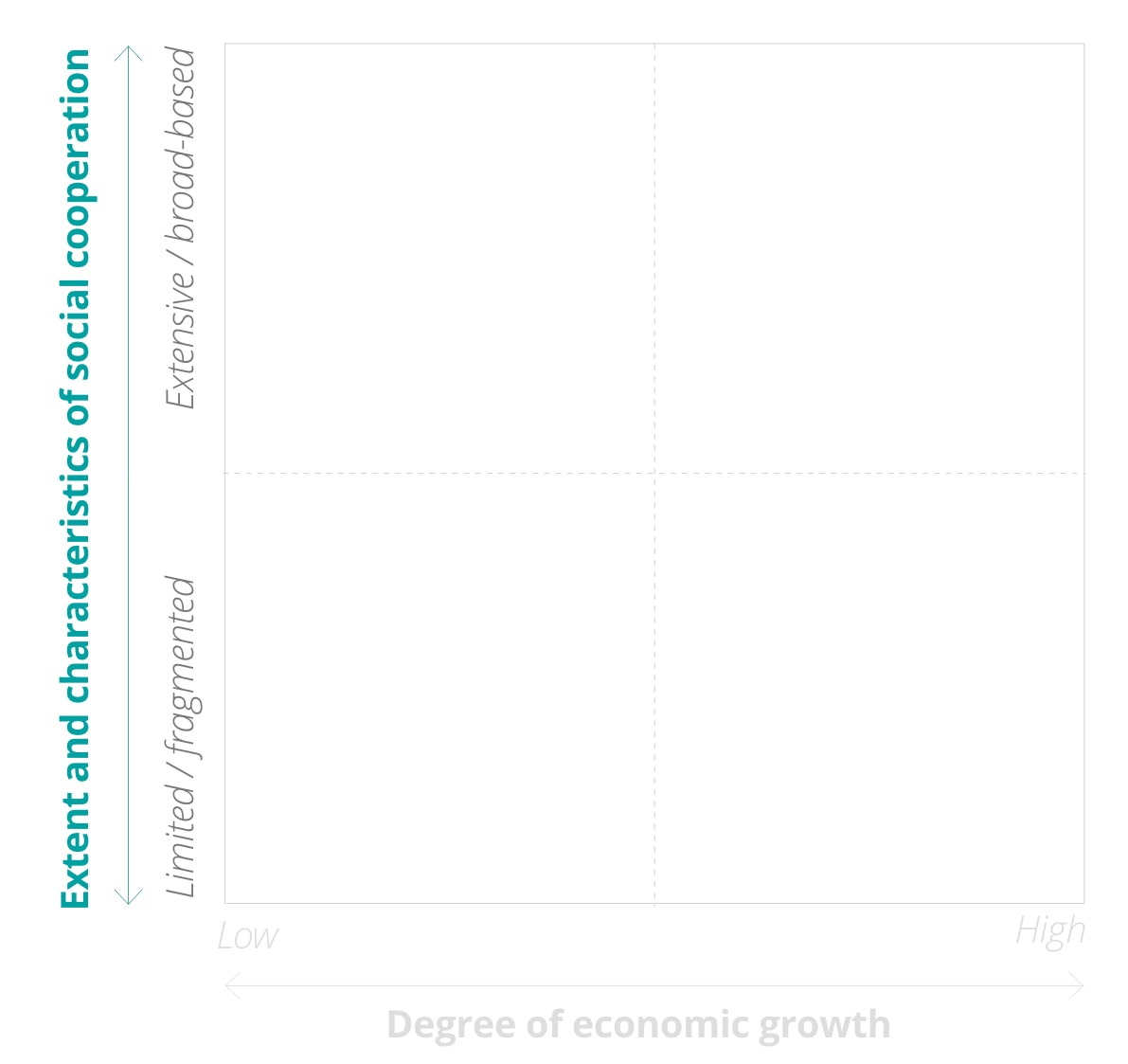
Rather than think of the two as an opposed pair of pure absolutes, consider this uncertainty as a continuum that could tend more toward one side or the other over time.
The second uncertainty is the degree of economic growth over the next decade. The level and distribution of economic prosperity across regions, communities, and socioeconomic backgrounds remains unknown and will likely have significant implications for whether and how American society might progress toward a more equitable future.

The simplest way to measure this is by asking whether macroeconomic growth over the next decade will be relatively high or low, which in turn suggests whether or not economic opportunity in the aggregate will grow.
Understanding the implications of either one of these uncertainties on its own could illuminate useful stories about the conditions for increasing or decreasing racial equity in the future. But combining these uncertainties allows for richer, more varied, and, in some ways, more challenging narratives about the journey toward equity over the next decade—especially when a handful of other important uncertainties are also woven into the scenarios, including:
- Public expectation of organizational and corporate behavior
- Primary measure of business performance (value for shareholders versus value for all stakeholders)
- Ambition and efficacy of public policies addressing inequity
- Deployment of and access to digital technologies and skills
By framing the scenarios around the two fundamental uncertainties—and then layering in some of these other uncertainties into each scenario to fill out the picture—we discover four very different visions of where the United States might be on the journey toward racial equity 10 or more years from now.
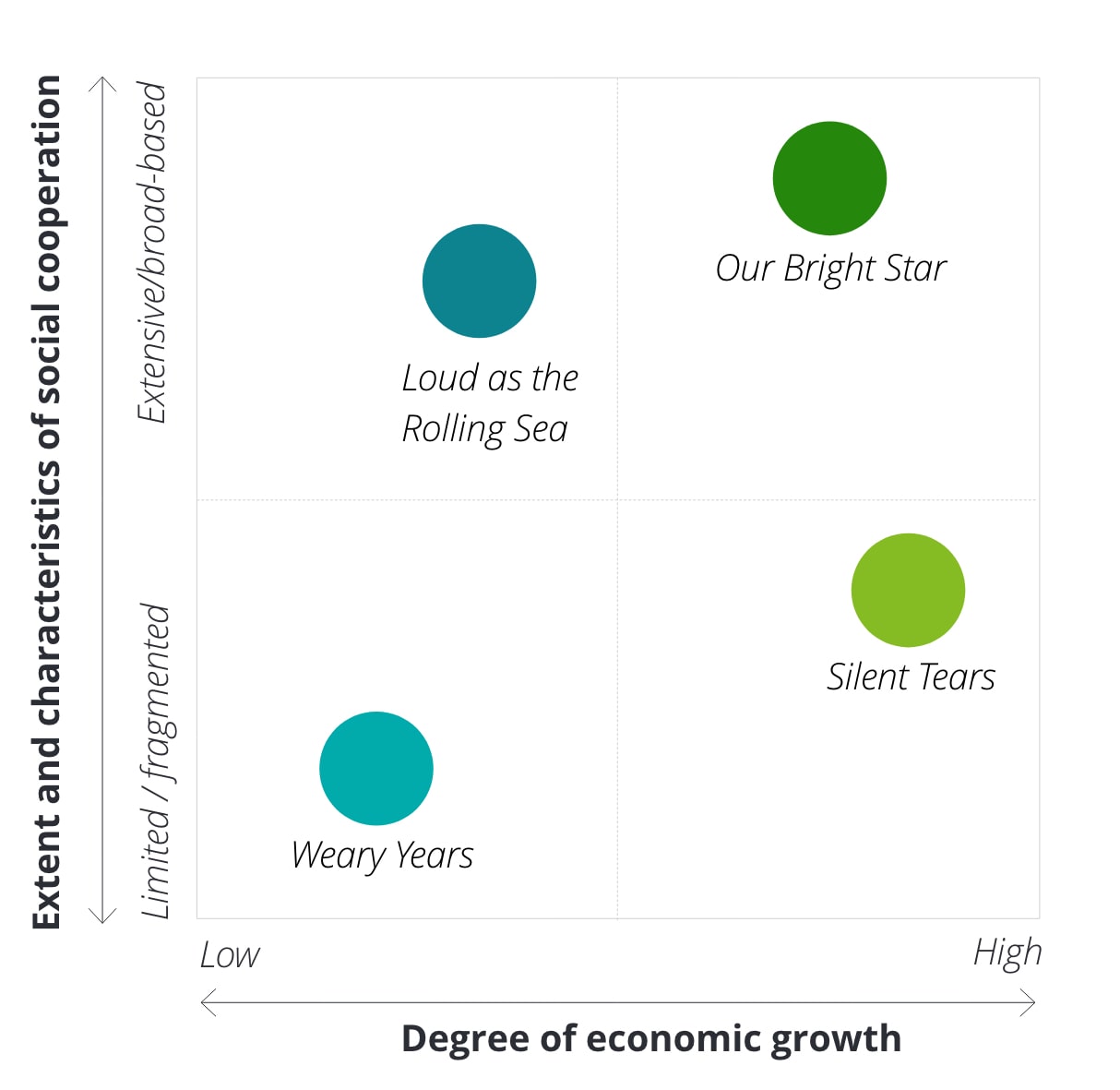
The four scenarios are Weary Years, Loud as the Rolling Sea, Silent Tears, and Our Bright Star. Each of these scenarios has a name taken from “Lift Every Voice and Sing,” a poem written in 1900 by James Weldon Johnson, set to music by his brother, J. Rosamond Johnson, and adopted by the NAACP as the “Negro National Anthem” in the 1920s. As noted in a recent essay in Smithsonian magazine, the song refers to “key symbols from Black history and culture … honoring the painful past and articulating optimism for the future.”1 That combination—acknowledging what has been and looking forward to what could be—inspires these scenarios.
FUTURE OF RACIAL EQUITY IN THE UNITED STATES (2030—2035)
Scenarios overview
Weary Years
Economic decline and periodic outbreaks of deadly violence, combined with enduring populism and partisanship, create a house divided against itself. Public concern for safety creates demands for stronger law enforcement capabilities and more sophisticated security technologies in daily life. While some companies make strides to advance Black individuals and other PEERs, there is less urgency for racial equity. Progress across business and government is fragmented and inconsistent.
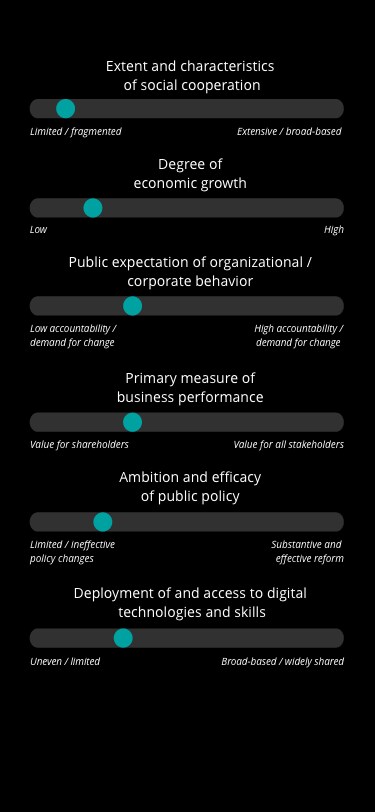
Loud as the Rolling Sea
Climate stress is felt everywhere, but the impacts are most pronounced for low-income individuals and PEERs. The result is a new consensus forged by a new generation of political leaders to rebuild industries and communities with a greater focus on equity. Thanks to the large and increasingly powerful cohort of voters that have rallied around a commitment to more inclusive prosperity, policymakers increasingly link economic renewal and public investment to greater racial equity at work and in the community.
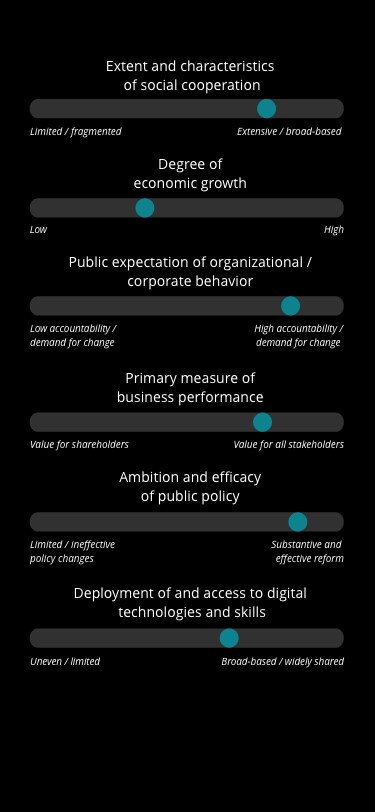
Silent Tears
Rapid technological innovation, light-touch regulation, and persistent low interest rates lead to absolute economic growth, the benefits of which are enjoyed disproportionately by just a few industries and communities. Workers are displaced by technology without sufficient reskilling. Culture becomes increasingly individualistic, as people prioritize their own economic security. Organizational leaders make symbolic commitments toward equity, but substantial gaps remain between racial and ethnic groups in wealth, health, opportunity, and social mobility.
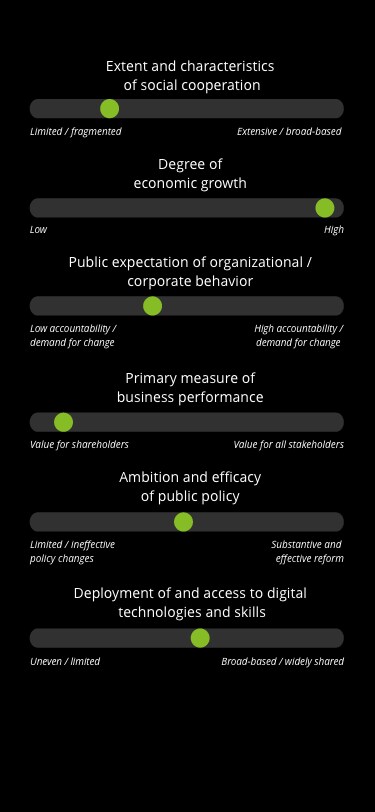
Our Bright Star
Public awareness of systemic inequity reaches a tipping point, with sustained demand for change and accountability from organizations. New federal and state legislation, while modest, raises expectations. But the private sector ultimately leads the way. Companies adopt new standards of transparency and are measured on their equitable outcomes. Talent, consumers, and investors migrate to companies that “walk the walk” by focusing on all stakeholders over a few shareholders. Powerful new alliances form to drive collective impact.
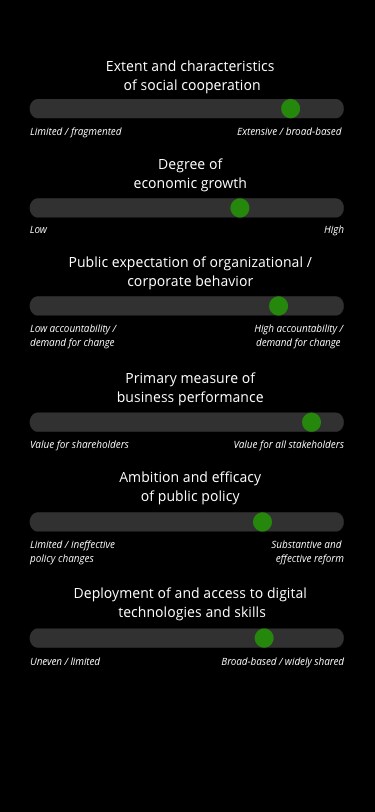
Weary Years
Imagine a future in which…
…some of the most challenging and divisive tensions of 2020 accelerate over the next decade, spreading further and entrenching deeply into American life. Economic decline and hardened partisan divides create sustained political turmoil and periodic outbreaks of violence in communities across the country.
Widespread doubts about the electoral system mean a growing number of Americans question the legitimacy of their political opponents. High levels of populism and partisanship lead to political swings as groups fight for dominance every election cycle, but no faction stays in charge for long. The country feels ever more like a house divided against itself.
Black activists and other PEERs protest deepening inequities in their communities, but are fragmented in their calls to action.
Some companies have advanced opportunities for Black individuals and other PEERs, but economic inequality has worsened steadily, in part due to the lasting effects of the COVID-19 pandemic that hit Black households, communities, and businesses especially hard. Many people withdraw to focus on security for their family and those closest to them. Money is scarce; trust is even scarcer.
Many big urban centers contract as people move to smaller, more homogenous communities they recognize as “their own,” further cementing division.
The urgency and energy for greater racial equity seen at the beginning of the decade is a distant memory, and the frustration many feel about the lack of progress threatens to boil over at any time.
LOUD AS THE ROLLING SEA
Imagine a future in which…
…the destruction unleashed by climate change accelerates and overwhelms everything else. Raging wildfires, devastating storms, rising waters: The threat is felt everywhere.
Climate stress has displaced millions from their homes and jobs. Many businesses and even whole industries are suffering. Formerly vibrant places struggle. Unemployment rises, and the economy sinks. Americans demand action, and the country faces a crossroads: Will it be everybody for themselves, or will people band together in the face of a fundamental threat to the economy, their communities, and their homes?
Demographic shifts in the past decade have accelerated the power and visibility of communities of PEERs, even as they have borne the brunt of climate stress. As a result, a new generation of political leaders seeks to build the economy and restore communities with a greater focus on equity. More equitable outcomes, they believe, are critical to achieving better economic results. This leads to new policies to address the enduring effects of past discrimination, as well as significant investment in communities of PEERs as part of the broader energy transition.
By the mid-to-late 2020s, government regulation—to manage resources, shift the economy toward more sustainable energy, and direct investment in physical and digital infrastructure—is accepted, if not always embraced, in response to the severity of the challenge. Taxes on corporations and the very rich rise to support an expanded social safety net. The government actively directs investment and enforces regulation in support of these goals.
In response to new mandates, larger businesses are making gains in promoting Black talent and PEERs, diversifying their boards, and expanding their supplier bases. It is progress, and there is hope.
Still, given all the challenges business leaders need to balance, it sometimes feels like there isn’t much to celebrate.
silent tears
Imagine a future in which…
…rapid technological innovation, light regulation, and low interest rates lead to real economic growth—but its benefits are distributed disproportionately to just a few industries and communities. Market consolidation empowers a handful of increasingly large businesses, which become more and more central to the daily lives of billions around the world. Those companies reward their executives and shareholders handsomely. Meanwhile, workers in disrupted jobs feel it is “everyone for themselves” as they scramble to find new ways to make a living in a world where work feels less secure than ever.
The COVID-19 pandemic had made some inequities more stark, and companies took action to adapt, encouraged by new federal policies created to mitigate effects of those inequities. Over time, though, the deeper changes many had wished for never materialize, while a deeply divided electorate makes political compromise—and thus new law or policy on contentious issues—all but impossible.
While economic growth leads to absolute gains for some, the macro statistics hide large differences in quality of life and access to opportunity. Educational outcomes remain skewed, as wealthier school districts provide more and better settings for students to develop the technical skills employers need. Combined with technological changes to the workplace—especially the automation of traditional manufacturing and many relatively low-skilled jobs—and lack of access to reskilling opportunities, the economic prospects for poorer Americans and Black communities shrink even as financial markets thrive.
While there are some success stories, and many companies are proud of the commitments they’ve made to promote equity in the workplace, the gains are relatively limited. Substantial gaps between racial and ethnic groups in wealth, health, and social mobility turn out to be frustratingly hard to close.
our bright star
Imagine a future in which…
…the commitments made by a broad array of companies to promote racial equity in 2020 turn out to have been a real tipping point, accelerating equity not only in American business, but also in American society. Talented professionals find new opportunities. Businesses grow with more racially and ethnically diverse talent at every level. Investors are engaged and rewarded. New federal policy raises the floor and, as the nation’s largest employer, the government’s efforts affect millions. But company policies go further, gaining strength and showing real results over time. Workers notice, and talent migrates toward the companies that “walk the walk” toward equity. Consumers notice, supporting companies that reflect their values. And institutional investors notice, rewarding companies that make sustained efforts and show measurable results.
No company could do it alone—and no company has to. Environmental, social, and corporate governance (ESG) standards and requirements adopted in the early 2020s allow for more consistent and comparable reporting on diversity measures and equity outcomes, not just in terms of workforce composition, but also as a measure of real organizational power. Soon, a leading business publication uses ESG reports and other certification programs to rank companies by their progress toward racial equity. The rankings—which sort public companies by the number of Black people with profit and loss responsibility and business unit leadership, representation in the leadership/succession pipeline, attrition rates, supplier diversity, and more—grow to have a powerful effect, as talent gravitates to the companies that score well.
At the same time, business leadership groups set informal yet influential benchmarks for corporate purpose, creating shared expectations for the iconic companies that define success in the minds of many. Not all small and medium companies join in, but the culture is shifting unmistakably, led by the most visible and successful companies creating a new norm for what business success looks like. Investors are funding more and more Black entrepreneurs in the technology and health care industries, both growing sectors in a changing economy. Black talent is increasingly featured in media, and more Black nominees are elected to local, state, and federal office.
It’s hard to believe the progress achieved in less than a generation, but committed leadership, focused action, and new standards change what people believe and how they act, both within their workplace and far beyond it.
10 reflections on the scenarios
01
There are no guarantees that the future will be better than today.
Despite the energy, urgency, and commitment expressed by many companies today, there are plausible futures in which few real gains are made toward greater equity. Today’s hopes could easily become tomorrow’s disappointments.
02
Change at the pace of demography won’t deliver transformative results this decade.
While demography is a powerful force for change, and the transition of American society toward a more fully multiethnic and multiracial society is well underway, current estimates project that the country will not be a “majority-minority” (e.g., White Americans become the minority) country until the early 2040s. Equity is likely to be a “lag demography” indicator without concerted action.
03
Social change should be linked to economic change.
Efforts to increase equity need to account for the ways in which the economy could change and align action toward the sectors most likely to be engines of economic growth.
04
Economic growth and good intentions aren’t enough.
A growing economy does not appear to generate substantial change toward equity without deeper action.
05
The coming changes to work through automation, AI, and robotics could increase inequity.
The transition underway could create new barriers to equity if the technologies likely to reshape work disproportionately disrupt jobs held by Black individuals.
06
The game won’t change if the rules don’t change.
In the futures with the most substantive gains in racial equity, success is incentivized and measured differently than it is now. In those more equitable futures, greater equity is a core measure of business success, and organizations with high levels of it are rewarded.
07
It is difficult to imagine federal policy alone fixing issues of racial inequity.
The US government is the nation’s largest employer, and its actions and priorities can have lasting consequences for millions of Americans.2 However, almost 95% of US workers are not in the federal workforce.3 Major new laws and far-reaching government programs are put into effect in only one of the scenarios explored, “Loud as the Rolling Sea,” in response to the grave threat of climate change. State and local action, however, could advance equity in specific places and likely contributes to the positive results in “Our Bright Star.”
08
Business has the power to create a more equitable future if systemic changes can be set in motion.
The legal and regulatory norms that the government sets are powerful, but leave room for business to lead the way. Businesses can act quickly. They have strong incentives to source and develop the best available talent. And, through their normal activities, they—especially the largest and most successful companies—influence the broader ecosystem in which they operate. If oriented toward equity, those dynamics can create lasting change.
09
To go far, go together.
Driving racial equity broadly is beyond the power of any one organization. Working independently, organizations may achieve good results for themselves, but the broader system may not change. Acting together, whether in alliances or ecosystems, will likely generate greater and more enduring change that raises the standard for all.
10
There may be opportunities to link racial and social equity to other issues (like mitigating climate change) and grow the coalition committed to sustained and substantial action.
Tradition may cast issues as competing, but traction may come when those fighting them are allies.
From commitment to collective action
Organizations may hope for, and voice their commitments to, a more equitable future. But if they are to make real gains toward that goal, we believe businesses should consider the competitive dynamics governing the private sector today and step up to take powerful, courageous, collective action. Only then is it possible to accelerate the kind of positive, systemic change that no one individual company can create alone.
Leaders
Andrew Blau
US Leader – Eminence & Insights
Managing Director | Deloitte Consulting LLP
Joanne Stephane
Human Capital, US Leader –
HR Strategy & Solutions
Human Capital, Chief DEI Officer
Principal | Deloitte Consulting LLP
Janet Foutty
Executive Chair of the Board
Principal | Deloitte US
Kavitha Prabhakar
Chief Diversity, Equity, and Inclusion
Officer – Deloitte US Firms
Principal | Deloitte Consulting LLP
Team
Lauren Lubetsky
Strategy
Deloitte Consulting LLP
Ale Treviño
Customer & Marketing
Deloitte Consulting LLP
Devon Dickau
Diversity, Equity, and Inclusion
Client Service Practice
Deloitte Consulting LLP
Deshawn Adams
Diversity, Equity, and Inclusion
Client Service Practice
Deloitte Consulting LLP
Raj Tilwa
Strategy & Analytics
Deloitte Consulting LLP
Richard Jucks
Deloitte Consulting Platforms
Deloitte Consulting LLP
Endnotes
- Janelle Harris Dixon, “Why the Black National Anthem is Lifting Every Voice to Sing,” Smithsonian, August 10, 2020, https://www.smithsonianmag.com/smithsonian-institution/why-black-national-anthem-lifting-every-voice-sing-180975519.
- See, for example, White House, “Executive Order On Advancing Racial Equity and Support for Underserved Communities Through the Federal Government,” January 20, 2021.
- See, for example, Fiona Hill, “Public service and the federal government,” in Policy 2020, Brookings, May 27, 2020.



